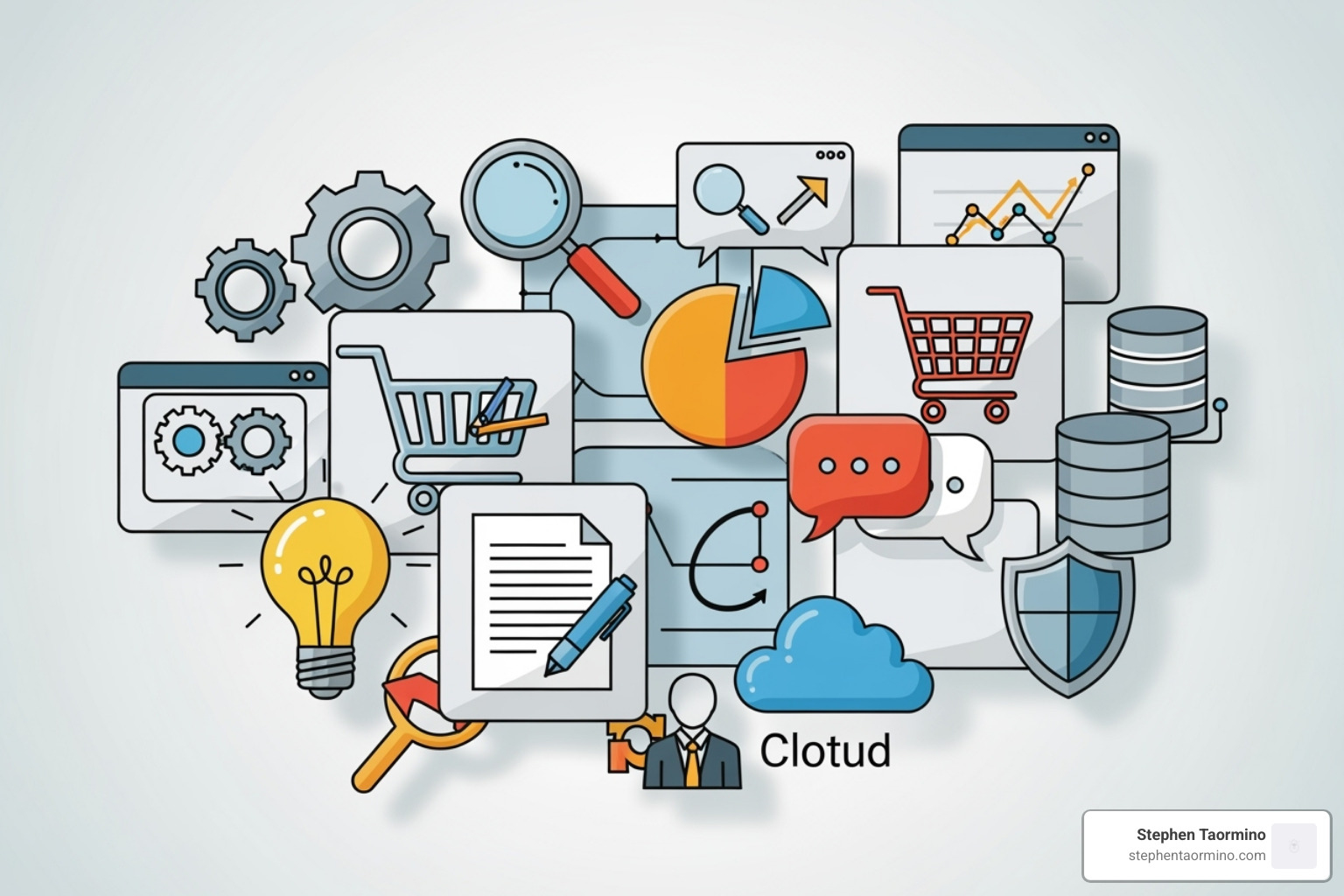Customer Engagement Automation Tool: Master 2025
Why Customer Engagement Automation is Critical for Modern Business Success
As businesses face mounting pressure to deliver personalized experiences at scale, the customer engagement automation tool has become essential. With 80% of customers valuing their experience as much as the product itself, manual, one-size-fits-all communication is no longer a viable strategy.
Customer engagement automation eliminates repetitive tasks, enabling fast, consistent communication across all channels. It uses data to analyze customer behavior, identify patterns, and deliver personalized experiences that drive both retention and revenue. The business impact is substantial, with companies reporting significant improvements in customer acquisition and service efficiency, reflecting a fundamental shift from reactive to proactive relationship management.
I’m Steve Taormino, and with over 25 years in digital marketing, I’ve seen how these tools transform customer connections. My expertise in marketing psychology has shown me that the best automation strategies don’t just save time—they create deeper, more meaningful relationships that drive sustainable growth. This guide will walk you through how to leverage these powerful tools for your business.
The Core Components of an Effective Customer Engagement Automation Tool
An effective customer engagement automation tool works like an orchestra conductor, coordinating various components to create a seamless customer experience. These sophisticated systems are designed to turn every interaction into a meaningful conversation.
The foundation is solid data management. The platform must collect, organize, and unify customer information from every touchpoint—purchase history, browsing behavior, and communication preferences—into unified customer profiles. Without this, personalization is impossible.
Next, journey orchestration allows you to map out potential customer paths and automatically guide them. Visual workflow builders make this process intuitive, enabling your system to respond instantly when a customer abandons a cart, downloads a guide, or reaches a milestone.
Omnichannel messaging ensures you can reach customers wherever they are, maintaining a consistent brand voice across email, SMS, social media, in-app messages, and chatbots. Each channel works in concert, adapted to its unique format but unified in its message.
Finally, analytics and reporting turn this activity into actionable insights. By tracking metrics like open rates, conversion rates, and satisfaction scores, you can understand what’s working. Our Customer Engagement Analytics Platform shows how powerful this data can be. A/B testing completes the toolkit, allowing you to continuously optimize messages, subject lines, and entire journeys to find what truly drives engagement.
How Automation Enables Hyper-Personalization
Customers don’t just want personalization; they expect it. A well-designed customer engagement automation tool is a game-changer for meeting this expectation.
- Customer data analysis is the backbone, uncovering patterns in behavior, preferences, and demographics to create highly relevant customer segments.
- Behavioral triggers respond to what customers do—or don’t do. A trigger can automatically send targeted recommendations after a user browses a product or a re-engagement campaign to an inactive customer.
- Predictive analytics uses advanced algorithms to anticipate churn risk, identify upsell opportunities, or determine the optimal time to send a message.
- Audience segmentation allows you to craft specific messages for groups based on purchasing habits, location, or lifecycle stage, making communication feel personal.
- Dynamic content and AI-driven recommendations create unique experiences by automatically adjusting message elements like product suggestions or images based on individual data.
This level of personalization drives real business results, increasing loyalty and lifetime value. Our work with AI-Driven Customer Engagement Solutions consistently shows this powerful connection.
Integrating with Your Existing Tech Stack
A customer engagement tool’s true power is open uped when it’s part of a connected ecosystem. CRM integration is at the heart of this, syncing valuable customer data so your sales, marketing, and service teams work from a single source of truth. Our insights on CRM Optimization Strategies for Sales Teams highlight why this is so critical.
Other key integrations include data warehouse sync for enterprise-wide reporting, APIs and webhooks for connecting disparate systems, and ad network synchronization to ensure consistent messaging across paid channels. When these integrations work smoothly, your team gains real-time insights that enable smarter communication and a unified customer experience.
The Transformative Benefits of Automating Customer Engagement
When I help companies implement a customer engagement automation tool, the change is remarkable. The benefits extend far beyond simple efficiency, reshaping how organizations connect with customers to drive sustainable growth.
The most immediate impacts are improved efficiency and cost savings. Teams are freed from repetitive tasks, allowing them to focus on strategy and relationship-building. Automation can handle a significant portion of customer interactions, representing real dollars returning to your bottom line.
Beyond cost savings, automation dramatically improves the customer experience. Customers receive fast, consistent, and personalized responses across every channel. This is critical, as 80% of customers now value their experience as much as the product itself. By analyzing individual data, platforms deliver content that feels uniquely crafted for each person, which in turn drives increased sales and revenue.
The cumulative effect is higher customer lifetime value. Engaged customers become loyal advocates who buy more and stay longer. This sustainable growth model is a key component of strategies for increasing digital marketing ROI.
Boosting Revenue and Retention
It costs five times more to acquire a new customer than to retain an existing one. A sophisticated customer engagement automation tool makes retention a strategic advantage by proactively identifying at-risk customers and intervening with targeted offers or content.
Key retention strategies include:
- Automated loyalty programs that create dynamic experiences rewarding specific behaviors.
- Upsell and cross-sell automation that analyzes purchase history to suggest relevant products at the perfect moment.
- Cart abandonment recovery, which triggers personalized follow-ups to recover otherwise lost sales. Some businesses have seen this single tactic reduce cart abandonment by over 60%.
These strategies align with marketing ROI best practices, creating a cycle where satisfied customers generate more revenue at a lower cost.
Elevating the Customer Experience
A well-implemented customer engagement automation tool creates memorable and appreciated customer interactions.
24/7 support availability via chatbots and AI agents provides instant answers to common questions, while a consistent brand voice across all automated communications builds trust. Automation also enables proactive communication, allowing you to inform customers about order delays or service issues before they have to ask.
By handling routine inquiries, automation significantly reduces wait times for complex issues that require a human touch. This frees up your expert agents to focus on high-value interactions. True engagement is about creating meaningful connections. Automation doesn’t replace human connection—it improves it by ensuring human interactions are timely, contextual, and more valuable.
A Guide to Customer Engagement Automation Tool Categories

Navigating customer engagement automation tool options can feel overwhelming, but the landscape generally breaks down into a few key categories. Your choice depends on your business size, needs, and long-term goals. You can either piece together specialized individual tools or invest in a comprehensive all-in-one platform. This decision is a core part of effective Customer Engagement Technology planning.
All-in-One Customer Engagement Platforms
These powerhouse platforms act as a central hub for your entire customer lifecycle, integrating marketing, sales, and service functions. They are best for businesses seeking a unified strategy, as they provide a single source of customer data for all teams. With advanced journey orchestration and cross-channel messaging, they are ideal for SaaS companies and large-scale e-commerce brands with complex customer journeys. While the investment can be higher, the operational efficiency often justifies the cost, especially when part of a thoughtful Digital Marketing Change Framework.
AI-Powered Customer Service Bots
These specialized tools focus on automating customer support through intelligent chatbots and virtual assistants. They are transformative for high-volume support teams, as they can handle the bulk of routine questions 24/7. This frees human agents to tackle complex, high-value interactions. With advanced natural language processing (NLP), these bots can handle multi-step inquiries and route issues to the right expert when human intervention is needed, dramatically improving response times and efficiency.
Specialized Social Media Engagement Tools
Social media is a critical channel for real-time customer service and engagement. These tools are designed to monitor, manage, and respond to conversations across multiple social platforms. Key features include brand monitoring (social listening), automated post scheduling, and a unified social inbox that consolidates messages into a single stream. They are particularly beneficial for B2C brands and community managers who need to maintain an active and responsive social media presence.
Onboarding and Feedback Automation Tools
These tools focus on two critical stages of the customer lifecycle: the first impression and the ongoing relationship. They help new users find value quickly through interactive product tours and in-app guides, which is essential for SaaS companies and mobile app developers. They also automate feedback collection through NPS and CSAT surveys, providing invaluable data for continuous improvement. By focusing on user activation and satisfaction, these tools directly impact retention and customer lifetime value.
How to Choose the Right Customer Engagement Automation Platform

Choosing the right customer engagement automation tool is about finding the best fit for your unique business needs. Think of it as selecting a strategic partner that can grow with you.
Consider these key factors:
- Business Size & Industry: Startups may prefer focused, single-purpose tools, while mid-sized businesses often need comprehensive platforms. Enterprises require robust solutions that handle massive data volumes. Your industry also matters—e-commerce needs strong personalization, while SaaS focuses on onboarding.
- Budget & Usability: Look beyond the subscription fee to consider integration and training costs. The platform should be intuitive for your team; a powerful tool is useless if it’s too difficult to manage.
- Integration & Scalability: Your platform must connect seamlessly with your existing CRM, data warehouse, and other tools. Most importantly, choose a solution that can scale with your business, handling more data and more complex journeys as you grow. This foresight is a key part of a solid Digital Change Strategy.
Key Features to Look for in a Customer Engagement Automation Tool
When evaluating platforms, prioritize these essential features:
- AI and Machine Learning: Look for AI-driven content recommendations, predictive analytics, and algorithms that optimize message timing.
- Visual Journey Builder: An intuitive, drag-and-drop interface allows non-technical teams to design complex, multi-channel automation workflows.
- Robust Analytics: Comprehensive, customizable reports are crucial for understanding performance and making data-driven decisions.
- Omnichannel Support: The ability to manage email, SMS, social media, and in-app messages from one platform is essential for a consistent customer experience.
- Security and Compliance: Strong data encryption, access controls, and compliance with regulations like GDPR and CCPA are non-negotiable.
Future Trends in Engagement Automation
The automation landscape is evolving rapidly. Keep an eye on these trends, which are central to broader Digital Marketing Industry Trends:
- Hyper-Personalization at Scale: AI will enable true one-to-one experiences, adapting content and tone in real-time based on behavioral cues.
- Predictive Engagement: Systems will anticipate customer needs and potential issues, allowing for proactive support before a problem even arises.
- Conversational AI Evolution: Chatbots and virtual assistants will handle more complex, nuanced conversations with greater empathy.
- Integration with IoT and AR: Engagement will extend to connected devices, opening new touchpoints for personalized interactions and immersive brand experiences.
Frequently Asked Questions about Customer Engagement Automation
Over my years helping businesses steer this space, a few key questions about using a customer engagement automation tool come up repeatedly. Here are the answers to the most common ones.
What is the difference between a CRM and a customer engagement platform?
This is a common point of confusion. Think of your CRM (Customer Relationship Management) system as your digital filing cabinet—it stores and organizes everything you know about your customers, like contact info and purchase history. It’s a system of record.
A customer engagement platform, on the other hand, is a system of action. It uses the data from your CRM to orchestrate conversations. While the CRM tells you who your customers are, the engagement platform helps you decide how and when to communicate with them through personalized, automated messages and journeys. The two systems work best when tightly integrated.
What is the primary goal of customer engagement automation?
The ultimate goal isn’t just efficiency—it’s building stronger customer relationships at scale. We use technology to make interactions feel more human and personal, not less.
By delivering the right message at the right time, automation helps you:
- Improve customer loyalty by creating moments of genuine value.
- Improve retention by identifying at-risk customers and re-engaging them proactively.
- Drive revenue as a natural result of increased loyalty and satisfaction.
The goal is to foster an emotional connection with your brand, which is the strongest predictor of long-term business success.
How does automation impact marketing psychology?
This is where automation becomes truly powerful. When implemented thoughtfully, it allows us to apply key psychological principles at scale.
- Timeliness and Relevance: Delivering exactly what a customer needs, when they need it, taps into the principle of reciprocity. This helpfulness creates a positive association with your brand.
- Reducing Friction: Smart automation removes unnecessary steps and cognitive load, making interactions feel effortless and encouraging repeat engagement.
- Building Habits: Consistent, valuable interactions—like a weekly insights email or personalized recommendations—build routines that connect your brand with positive experiences.
- Personalization and Validation: Using a customer’s name, remembering their preferences, and acknowledging their history satisfies the deep human need to be seen and understood.
As I often discuss in my Marketing Psychology Insights, the most effective automation doesn’t feel automated. It feels like a thoughtful, attentive team member looking out for each customer, a core concept in Behavioral Economics Marketing Techniques.
Conclusion: Build Stronger Relationships Through Smarter Automation
The journey we’ve taken together through customer engagement automation tools reveals a clear truth: automation isn’t just about efficiency anymore. It’s about creating meaningful connections at scale, something that seemed impossible just a few years ago.
Think about what we’ve uncovered. These platforms don’t just send messages—they orchestrate entire customer experiences. They turn mountains of data into personalized conversations. They predict what customers need before customers even realize it themselves. Most importantly, they free up our human teams to focus on what they do best: building genuine relationships and solving complex problems.
The change is real and measurable. We’ve seen companies achieve significant increases in customer acquisition, reduce service wait times, and boost customer lifetime value. These aren’t just numbers on a dashboard—they represent real people having better experiences with brands they trust.
But here’s what excites me most about the future of customer engagement: the technology is getting smarter while becoming more human. AI that understands context and emotion. Predictive systems that anticipate needs. Conversational interfaces that feel natural and helpful. We’re moving toward a world where automation improves human connection rather than replacing it.
Strategy and psychology remain at the heart of success. Throughout my 25+ years in this industry, I’ve learned that the most powerful automation strategies aren’t built on technology alone. They’re built on understanding how people think, what they value, and how they want to be treated. The companies that win are those that use automation to amplify empathy, not eliminate it.
The path forward is clear. Whether you’re a startup looking to punch above your weight or an enterprise seeking to scale personal touch, the right customer engagement automation tool can open up possibilities you haven’t even imagined yet. The question isn’t whether you need automation—it’s how quickly you can implement it strategically.
Your customers are waiting for experiences that feel crafted just for them. They want brands that understand their journey and support their success. They deserve communication that adds value to their lives, not noise to their inbox.
This is your moment to transform how you connect, engage, and grow. The tools exist. The strategies work. The only thing standing between you and stronger customer relationships is taking that first step toward smarter automation.
Ready to find what’s possible when technology meets human understanding? Let’s build something amazing together.
Explore our customer engagement solutions to transform your business

